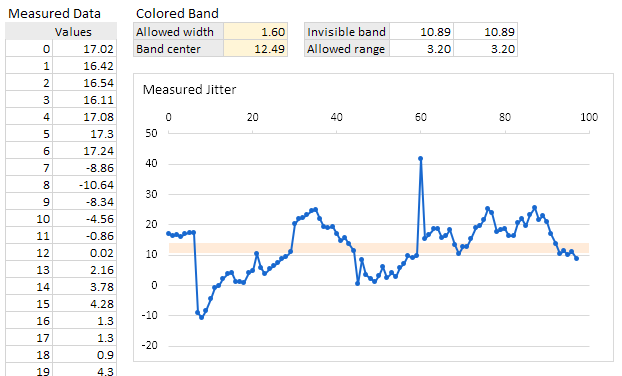i have a dataset which can be converted into a graph
how do i get an overlapping graph showing the average of the highs and lows
1 17.02
2 16.42
3 16.54
4 16.11
5 17.08
6 17.3
7 17.24
8 -8.86
9 -10.64
10 -8.34
11 -4.56
12 -0.86
13 0.02
14 2.16
15 3.78
16 4.28
17 1.3
18 1.3
19 0.9
20 4.3
21 4.7
22 10.5
23 5.86
24 3.96
25 5.4
26 6.44
27 7.32
28 8.78
29 9.48
30 10.98
31 20.32
32 21.86
33 22.42
34 23.34
35 24.74
36 24.96
37 21.9
38 19.44
39 19
40 19.24
41 16.86
42 14.62
43 15.64
44 13.64
45 11.3
46 0.44
47 8.52
48 3.64
49 2.32
50 1.18
51 3.24
52 6.2
53 2.54
54 4.22
55 2.94
56 5.96
57 7.28
58 9.75
59 9.22
60 9.78
61 41.7
62 15.4
63 16.78
64 18.62
65 18.6
66 15.72
67 16.28
68 18.44
69 13.4
70 10.56
71 12.58
72 12.68
73 15.32
74 18.9
75 19.48
76 21.66
77 25.25
78 24.06
79 17.8
80 18.22
81 18.76
82 16.32
83 16.44
84 20.48
85 22.1
86 19.64
87 23.14
88 25.42
89 21.58
90 22.94
91 20.96
92 17.12
93 13.74
94 10.5
95 11.44
96 10.08
97 11.1
98 8.84
how do i get an overlapping graph showing the average of the highs and lows
1 17.02
2 16.42
3 16.54
4 16.11
5 17.08
6 17.3
7 17.24
8 -8.86
9 -10.64
10 -8.34
11 -4.56
12 -0.86
13 0.02
14 2.16
15 3.78
16 4.28
17 1.3
18 1.3
19 0.9
20 4.3
21 4.7
22 10.5
23 5.86
24 3.96
25 5.4
26 6.44
27 7.32
28 8.78
29 9.48
30 10.98
31 20.32
32 21.86
33 22.42
34 23.34
35 24.74
36 24.96
37 21.9
38 19.44
39 19
40 19.24
41 16.86
42 14.62
43 15.64
44 13.64
45 11.3
46 0.44
47 8.52
48 3.64
49 2.32
50 1.18
51 3.24
52 6.2
53 2.54
54 4.22
55 2.94
56 5.96
57 7.28
58 9.75
59 9.22
60 9.78
61 41.7
62 15.4
63 16.78
64 18.62
65 18.6
66 15.72
67 16.28
68 18.44
69 13.4
70 10.56
71 12.58
72 12.68
73 15.32
74 18.9
75 19.48
76 21.66
77 25.25
78 24.06
79 17.8
80 18.22
81 18.76
82 16.32
83 16.44
84 20.48
85 22.1
86 19.64
87 23.14
88 25.42
89 21.58
90 22.94
91 20.96
92 17.12
93 13.74
94 10.5
95 11.44
96 10.08
97 11.1
98 8.84







